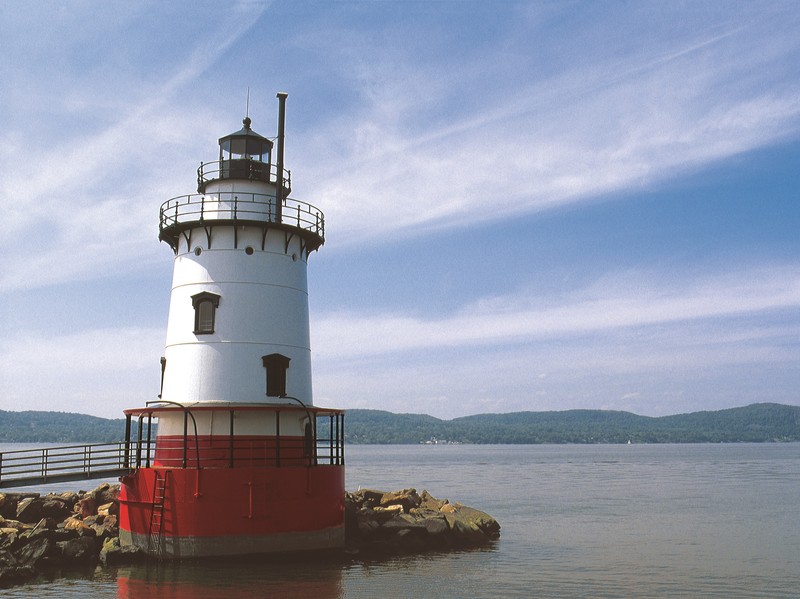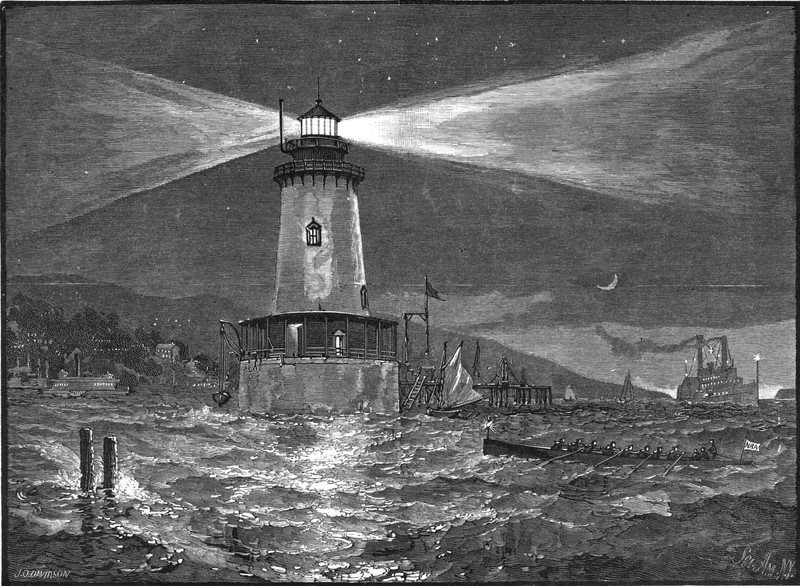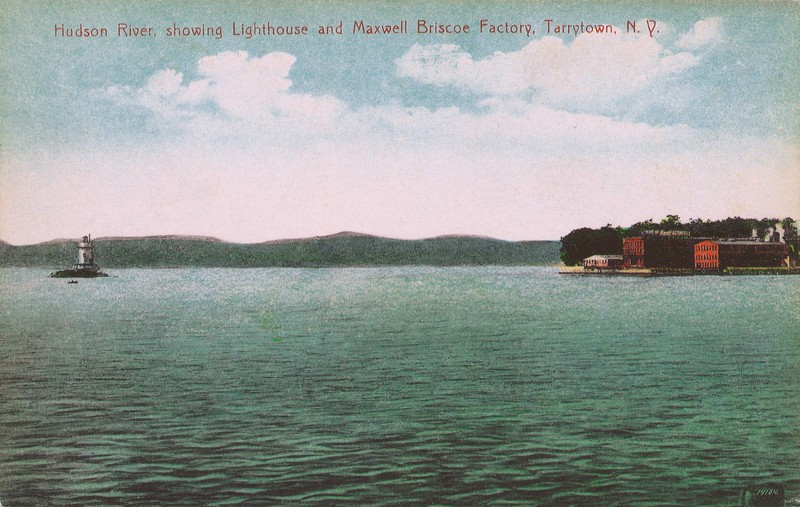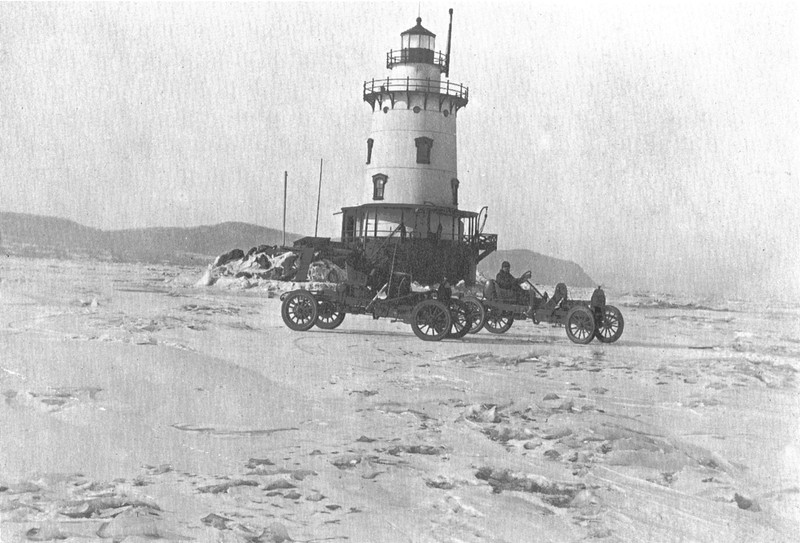Tarrytown Lighthouse, Sleepy Hollow
Introduction
Text-to-speech Audio
Images
Tarrytown Lighthouse Exterior

New Government Lighthouse at Tarrytown (1884)

Hudson River Lighthouse and Maxwell-Briscoe Factory (1910)

Lighthouse with Auto Racers on Frozen Hudson River (1912)

Backstory and Context
Text-to-speech Audio
Constructed in the late 19th century, the Tarrytown Lighthouse was built in response to pleas by local steamship companies for assistance in navigating dangerous shoals. It is significant as the only lighthouse in Westchester County. It is also the only conical steel structure in Westchester to include living quarters for its occupants. The lighthouse’s exterior prominently features three painted colors. The majority of the structure’s length is white, with a red concrete pier at the bottom, accompanied by a Black lantern room at the top. “It was built to mark a dangerous area off the Tarrytown shoals at a time when river commerce was at its peak.”1
Regarding the layout of the structure, “the foundation is solid concrete, encased in a cylinder of cast-iron plates. The walls of the lighthouse itself are also built of heavy iron plates, and the lower floors are reinforced by an inner wall of brick.”2 The lighthouse has eight windows to illuminate the residential quarters, as well as eight portholes, providing ample light to the interior during the day. When the lighthouse was built, electricity was not available. “Originally all household lighting was provided by kerosene lamps, as was the light in the tower.”3
The first floor of the structure includes the entrance to the lighthouse as well as the main living area (living room and kitchen). The second and third floors are dedicated to a single bedroom each. The fourth floor contains a bedroom and workspace for machinery repair, and features a ladder to access the fifth floor, where the watch room & fog bell machinery are located. Above this all is the lantern room, fully surrounded by a railed walkway, and enclosed with multiple glass panels that allow light to move down to the watch room.
A few months after the lighhouse began operation in 1884, it was featured in Scientific American as an engineering marvel, citing its strong beacon as a powerful device to increase safety on the Hudson River.The first occupant of the lighthouse, Jacob Ackerman, served as keeper for 21 years, and recorded his observations. “He kept a journal until 1904 that described shipwrecks and rescues on the Hudson”4 With many rescues in his lifeboat, it is needless to say that he took his duties in a very serious manner. “During his services as keeper, Capt. Ackerman rescued 19 persons, at times pushing the bow of his lifeboat into angry waters - his oars muffled by the roar of the surf that crashed like mighty sledge hammers upon the distant shore.”5
Originally the lighthouse was located a mile out in the River channel, but shoreline extensions and landfills decreased this distance to about 50 feet by 1996. The lighthouse was initially lit by kerosene lamps and battery operated mechanisms, until it was equipped with electricity in 1947 . Not long after, the Tappan Zee Bridge was constructed, which featured sufficient lighting for itself and the surrounding area. The light from the bridge outshone that of the lighthouse, which ultimately led to the deactivation of the lantern light in 1961. The lighthouse was decommissioned in 1965, as its light and bell had become obsolete. It was offered to Westchester County to be used as a museum, and was added to the National Register of Historic Places in 1979.
Cite This Entry
Terry Ariano on behalf of Westchester County Historical Society. "Tarrytown Lighthouse, Sleepy Hollow." Clio: Your Guide to History. March 4, 2020. Accessed March 27, 2025. https://theclio.com/tour/1673/9
Sources
- Barry, Elise M.. Hudson River Lighthouses Thematic Group. National Register of Historic Places Inventory. Published February 26th 1979.
- Williams, Gray. Picturing Our Past: National Register Sites in Westchester County . Elmsford , NY. Westchester County Historical Society , 2003.
- Barry, Elise M.. Hudson River Lighthouses Thematic Group. National Register of Historic Places Inventory. Published February 26th 1979.
- N/A. Historical Society Landmark Recognition in Tarrytown and Sleepy Hollow. The Chronicle. Published April 1st 2001.
- N/A. "Tarrytown Lighthouse: Served 78 Years." Westchester Today (Westchester) August 24th 1961.
Williams, Gray. Picturing Our Past: National Register Sites in Westchester County . Elmsford , NY. Westchester County Historical Society , 2003.
Williams, Gray. Picturing Our Past: National Register Sites in Westchester County . Elmsford , NY. Westchester County Historical Society , 2003.
Williams, Gray. Picturing Our Past: National Register Sites in Westchester County . Elmsford , NY. Westchester County Historical Society , 2003.
Williams, Gray. Picturing Our Past: National Register Sites in Westchester County . Elmsford , NY. Westchester County Historical Society , 2003.

